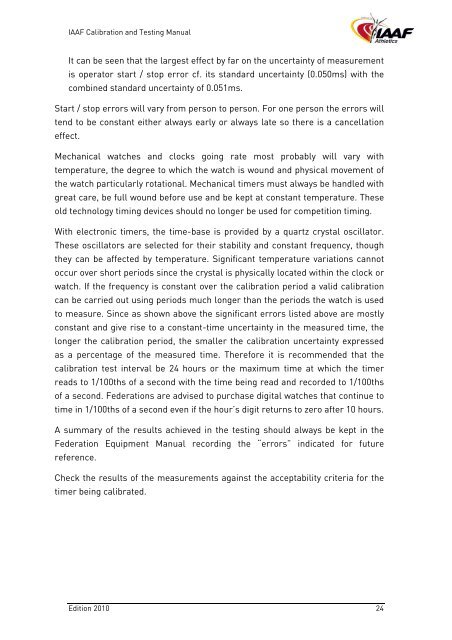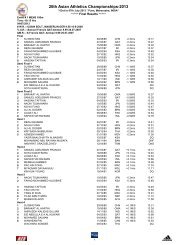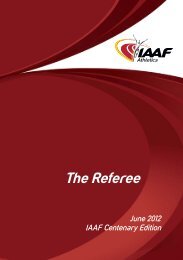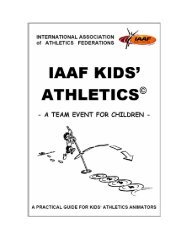IAAF Calibration and Testing Manual - Asian Athletics Association
IAAF Calibration and Testing Manual - Asian Athletics Association
IAAF Calibration and Testing Manual - Asian Athletics Association
You also want an ePaper? Increase the reach of your titles
YUMPU automatically turns print PDFs into web optimized ePapers that Google loves.
<strong>IAAF</strong> <strong>Calibration</strong> <strong>and</strong> <strong>Testing</strong> <strong>Manual</strong><br />
It can be seen that the largest effect by far on the uncertainty of measurement<br />
is operator start / stop error cf. its st<strong>and</strong>ard uncertainty (0.050ms) with the<br />
combined st<strong>and</strong>ard uncertainty of 0.051ms.<br />
Start / stop errors will vary from person to person. For one person the errors will<br />
tend to be constant either always early or always late so there is a cancellation<br />
effect.<br />
Mechanical watches <strong>and</strong> clocks going rate most probably will vary with<br />
temperature, the degree to which the watch is wound <strong>and</strong> physical movement of<br />
the watch particularly rotational. Mechanical timers must always be h<strong>and</strong>led with<br />
great care, be full wound before use <strong>and</strong> be kept at constant temperature. These<br />
old technology timing devices should no longer be used for competition timing.<br />
With electronic timers, the time-base is provided by a quartz crystal oscillator.<br />
These oscillators are selected for their stability <strong>and</strong> constant frequency, though<br />
they can be affected by temperature. Significant temperature variations cannot<br />
occur over short periods since the crystal is physically located within the clock or<br />
watch. If the frequency is constant over the calibration period a valid calibration<br />
can be carried out using periods much longer than the periods the watch is used<br />
to measure. Since as shown above the significant errors listed above are mostly<br />
constant <strong>and</strong> give rise to a constant-time uncertainty in the measured time, the<br />
longer the calibration period, the smaller the calibration uncertainty expressed<br />
as a percentage of the measured time. Therefore it is recommended that the<br />
calibration test interval be 24 hours or the maximum time at which the timer<br />
reads to 1/100ths of a second with the time being read <strong>and</strong> recorded to 1/100ths<br />
of a second. Federations are advised to purchase digital watches that continue to<br />
time in 1/100ths of a second even if the hour’s digit returns to zero after 10 hours.<br />
A summary of the results achieved in the testing should always be kept in the<br />
Federation Equipment <strong>Manual</strong> recording the “errors” indicated for future<br />
reference.<br />
Check the results of the measurements against the acceptability criteria for the<br />
timer being calibrated.<br />
Edition 2010 24






